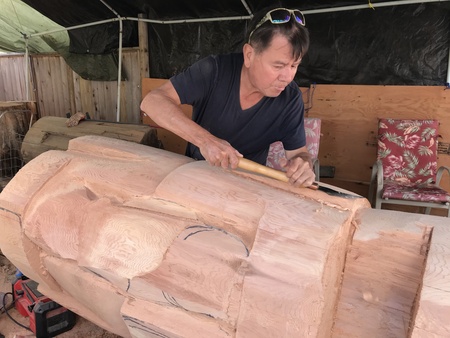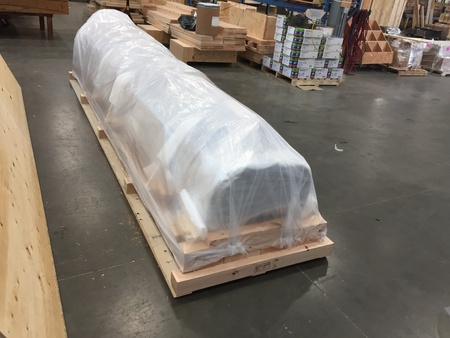Factoring in Japan with Canada has always been a juggling act. For generations it has been a “S/he loves me, s/he loves me not” relationship. Some find it necessary while others don’t: more than ever, identity is a complex selection of personal choices.
So, does being Japanese Canadian in 2021 even require a relationship with Japan, I wonder? Should we choose to include “Japanese”, then how do you define it for yourself? Are you simply gleefully (happy face emoji) Nikkei, or might there be something more substantial to that self identity?
Most recently, at least since the Sister City (Oakville, Ontario’s Sister City is Neyagawa) and Homestay programs, one of the most exciting initiatives to build cultural bridges with Japan is the Wakayama Totem Pole Project, initiated by North Vancouver’s Sammy Takahashi. The remarkable totem pole was carved by Squamish Nation Master Carver Darren Yelton (ancestral name: K’na’kweltn) of West Van.
Now in Japan, the totem pole will be erected in Miomura (aka “Amerikamura”), Wakayama, in honour of businessman philanthropist Issei Gihei Kuno (1854-1917) and the thousand of others who followed in his footsteps to help the village to prosper.
The project brings together First Nations (Squamish Nation), Japanese Canadian and Canadian cultures in unique ways, sparking interesting synergies.
Miomura is the village where many of our JC fishermen and fisheries worker descendants in places like Steveston came from more than 100 years ago.
The totem pole was commissioned by businessman Toshio Takai (Himeji, Japan) whose own roots go back to Mio through his great grandfather Gihei Kuno.
* * * * *
Originally from Tokyo, a director of the Committee for Promoting International Cooperation, Sammy Takahashi moved to Vancouver, BC in 1991 to set up an English as a Second Language school for a Tokyo-based company. He received a BA from California State University, Fresno, and taught English in Japan for 10 years before moving to Canada where he founded Pacific Gateway College in 1994. Today, he’s one of the founders and a director of the Asahi Baseball Association and a director of the Committee for International Cooperation.
He lives in North Vancouver with partner, Yasuko, who teaches the tea ceremony.
What is your personal connection to the project?
I’m president of the Japan-Canada Chamber of Commerce. One of our missions is to connect Japan and Canada through business, culture, education, and tourism. I wanted to help strengthen the Sister City relationship between Wakayama and Richmond, BC by doing this.
Where, when and who started it? Can you talk a bit about Toshio Takai?
The delegation from Mio, Wakayama visited Vancouver in October 2018. They told the local newspaper about the village of Mio where Gihei Kuno was from, which thrived before World War ll. Thousands of people from the village came to Vancouver and settled in Steveston where Gihei Kuno made a fortune from the salmon fishery. These people traveled back and forth between Mio and Steveston for decades.
Mio flourished thanks to the money they made from the fishery. However, these days, Mio is deserted since the majority of young people left the village. Now mostly seniors live there. People of the delegation wanted to get some outside help to rejuvenate Mio. When I read the article, I instantly became interested in this and came up with my plan to rejuvenate the village. One of the ideas was to create a landmark to attract tourists from all over Japan as well as from overseas. There’s no other place in Japan like Mio where so many people emigrated overseas. In 2019, I was lucky to be able to find Toshio Takai, great grandson of Gihei Kuno in Himeji, Japan. He decided to give financial support to this project. This is how everything started.
What kind of business does he run in Himeji?
He is chairman of KK Network Group. He runs several businesses involving 20,000 small and medium-sized businesses around Japan.
Did he always maintain a connection with Canada through his relatives?
He did until about 10 years ago, but found it extremely difficult to maintain it as time went by.
When did they return to Japan?
Gihei once returned to Japan in 1900 which was 12 years after he arrived in Canada.
He had severe arthritis. He spent three months trying to get healed in Shirahama where there are famous hot springs. (Many people went there for rest and relaxation to recover from illness in the old days.)
He then returned to Steveston with his son, Yoshijiro and his daughter, Fujiko. Gihei permanently went back to Wakayama in 1911 with his granddaughter, Yukiko who’s Toshio Takai’s mother. Yoshijiro and Fujiko remained in Canada. Gihei died in 1917 at the age of 63 in Mio.
Can you please describe some of the post-WW2 family history?
The monument commemorating Gihei was built in Mio in 1931. Gihei was called “the father of immigrants”. In 1988, Kuno Garden was created in Steveston with with his family and immigrants from Wakayama and their descendants from Steveston in attendance. It was created to commemorate the 100th anniversary of Gihei’s arrival in Steveston.
Miomura is the same place, correct?
At present, it’s part of Mihama-cho, Hidaka-gun.
Can you please talk about how the project got started? Why a totem pole?
I heard that there was an influential member of the town council who was interested in getting a totem pole erected in Mio, but it did not happen before he passed away a few years ago. I thought a totem pole could become a symbol of the friendship between Japan and Canada.
How did you get into contact with Master Carver Darren Yelton? What was his response when the project idea was presented to him?
One day, I happened to find a beautiful totem pole inside Save On Foods supermarket in my neighbourhood when I went grocery shopping and couldn’t believe my eyes. I always went grocery shopping there, but had never actually seen it before. It was brand new. I went to the customer service desk and asked who made the totem pole. The person who worked there knew Darren Yelton. She passed on my phone number to him. Darren was excited about what I told him about this totem pole project. He’s a member of Squamish Nation. He lives close to me.
Can you please talk a bit about Darren?
He’s done more than 10 totem poles all over North Vancouver. I chose him since he’s a master carver who’s been carving totem poles for over 45 years.
Is there a historic connection between the Squamish Nation and Japanese Canadians?
I heard that the Squamish Nation people helped Japanese fishermen catch salmon in the early days. They were both heavily discriminated against by the Caucasian people.
Can you describe the totem pole? What is the meaning of each of the images carved into it?
The totem pole is 13-feet tall and weighs 1700 lbs. It’s made from a 350-year-old red cedar. It has a bald eagle, a Welcome Man, a grizzly bear and salmon. The bald eagle represents power and prestige, the grizzly bear is a symbol of divinity and salmon represent the cycle of life.
Do you make any connection with Shintoism and the totem pole?
I believe there’s a commonality between Shintoism and a kind of shamanism which the First Nation people believe in.
Has the pole been erected in “Amerikamura” yet?
Not yet. It’s scheduled to leave Vancouver on February 18th and arrive in Osaka on March 4th. It’ll be carried to Mio, Wakayama where it’ll be erected sometime in late spring.
How do the residents of that area feel about the totem pole?
They are quite excited about this gift. They’ll also get a statue of Gihei Kuno from Toshio Takai which will also be erected near the totem pole in Mio.
Can you describe the connection of “Amerikamura” with Canada to this day?
The City of Wakayama and the City of Richmond have been ‘Sister Cities’ since 1973. They have been actively engaged in projects and exchanges that promote cultural awareness and joint learning opportunities. One of the educational exchanges is that a group of high school students from both cities visit each other’s city every two years.
Why has it endured for so long?
That’s because there are still many descendants of people who were originally from Wakayama in Steveston and Richmond, BC today who have been thoroughly enjoying the close ties between Wakayama and Richmond as well as Japan and Canada.
Any final words?
For those who want to visit Mio to see the totem pole. Wakayama is a one-hour train ride from Osaka, two hours from Kyoto and Nara. It’s another one hour from Wakayama to Gobo which is the nearest JR train station. It’s another one hour to go to Shirahama which has a lot of well known hot springs.
Totem Pole Project Documentary by Japan-Canada Chamber of Commerce #3/English
* * * * *
Squamish Nation Master Carver Darren Yelton (ancestral name: K’na’kweltn)
“Being involved in this project with Sammy Takahashi has been very enjoyable. By carving this totem pole for Wakayama, Japan and to stand it in Mio means a lot. It means bringing two cultures together as one. In my culture, we say that thousands of years ago we all had a connection. We came here over the bridge between Asia and North American. Our Nation is recorded to have been here for at least 10,000 years. So, to be connected with the City of Mio is very humbling.
Bringing myself and Gihei Kuno together, even though he is on ‘the other side’, meant a lot to me. I felt comfortable carving it for this gentleman and it meant a lot to me because Japan is a place where my family would really love to visit. When I hear about the culture and history, it sounds like a country that is worth exploring. Just like Gihei Kuno, I am also an explorer and adventurer so we are almost like family already. I can’t wait to meet his grandchildren, grandson and family. If his great grandson, Toshio Takai, had not paid for this project, this connection would never have happened. The connection between us is there. Whenever I meet a new person, I think about the connection: it is a great feeling. The connection between Sammy Takahashi and myself is similar. Throughout the time I spent carving the totem pole, I felt the presence of Gihei there with me.”
© 2021 Norm Ibuki










